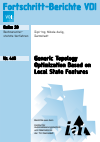Generic Topology Optimization Based on Local State Features
Zusammenfassung
The work at hand addresses engineers, designers and scientists who face the challenging Task of devising concept structures in a virtual product design process that involves more and more sophisticated physical simulations. Using methods of evolutionary optimization and machine learning, this dissertation explores a novel generic topology optimization algorithm, which is able to provide concept designs even for problems involving complex, black-box simulations. A self-contained learning component utilizes physical simulation data to generate a search direction. The generic topology optimization is studied in conjunction with statistical models such as neural networks or support vector regression. In empirical experiments, the novel method reproduces reference structures with Minimum compliance and provides innovative solutions in the domain of vehicle crashworthiness optimization.
Contents
Symbols and Abbreviations XIV
Abstract XVII
Zusammenfassung XVIII
1 Introduction 1
2 Fundamentals...
Schlagworte
- Kapitel Ausklappen | EinklappenSeiten
- I–XVIII
- 1–7 1 Introduction 1–7
- 8–28 2 Fundamentals 8–28
- 2.1 Background: Topology Optimization of Continuum Structures
- 2.1.1 General ProblemFormulation
- 2.1.2 Early Topology Optimization
- 2.1.3 Topology Optimization Approaches
- 2.2 Density-based Topology Optimization
- 2.2.1 ProblemFormulation
- 2.2.2 The Minimum Compliance Problem
- 2.3 Evolutionary Computation
- 2.3.1 Evolution Strategies
- 2.3.2 Covariance-Matrix Adaptation Evolutionary Strategy
- 2.4 Summary
- 29–47 3 Structure Representations for Evolutionary Computation 29–47
- 3.1 Representing the Structure
- 3.2 Grid Representation
- 3.2.1 Bit-Array Encoding
- 3.2.2 Real-Valued Array Encoding
- 3.3 Geometric Representation
- 3.3.1 Voronoi-cells
- 3.3.2 Material-Mask Overlay
- 3.3.3 Graph Representation
- 3.3.4 Level SetMethods
- 3.4 Indirect Representation
- 3.4.1 Lindenmayer System
- 3.4.2 Gene Regulatory Network
- 3.4.3 Compositional Pattern Producing Network
- 3.5 Discussion
- 3.6 Summary of Contribution
- 48–83 4 Topology Optimization by Predicting Sensitivities 48–83
- 4.1 Generic Update-SignalModel
- 4.1.1 Introduction
- 4.1.2 Replacing Sensitivities
- 4.1.3 Local State Features
- 4.2 Enclosing Topology Optimization
- 4.2.1 Improvement Threshold
- 4.3 Explicit Evolutionary Learning
- 4.3.1 Neural Network ApproximationModel
- 4.3.2 Piecewise-Constant Model
- 4.3.3 Optimization with CMA-ES
- 4.3.4 Computational Flow
- 4.4 Sampling and Supervised Learning
- 4.4.1 Sensitivity Estimation by Finite-Difference Sampling
- 4.4.2 Aggregated Sensitivity-Sampling
- 4.4.3 Sensitivity Regression Model
- 4.4.4 Computational Flow
- 4.5 Summary of Contribution
- 84–120 5 Studies on the Minimum Compliance Problem 84–120
- 5.1 Reference Problem
- 5.1.1 Linear Static LSF
- 5.2 NE/PCM-TOPS Experiments
- 5.2.1 Results LSF Vector I
- 5.2.2 Results LSF Vector II
- 5.2.3 NE/PCM-TOPS Results Discussion
- 5.3 SVR/LIN-TOPS Experiments
- 5.3.1 Results LSF Vector I
- 5.3.2 Results LSF Vector II
- 5.3.3 Intermediate LIN/SVR-TOPS Results Discussion
- 5.3.4 Mesh-Independency Study
- 5.3.5 Alternative LSF
- 5.3.6 Experiments with Aggregated Sampling
- 5.4 Overall Discussion
- 5.5 Summary of Contribution
- 121–149 6 Topology Optimization of Crashworthiness Objectives 121–149
- 6.1 State-of-the-art
- 6.2 Maximum Energy Absorption Beam
- 6.2.1 Beam Model and Optimization Set-up
- 6.2.2 Optimization Results
- 6.3 MinimumIntrusion Frame
- 6.3.1 Frame Model and Optimization Set-up
- 6.3.2 Optimization Results
- 6.4 Summary of Contribution
- 150–154 7 Conclusions 150–154
- 7.1 Main Results
- 7.2 Future Directions
- 155–160 A Theory 155–160
- A.1 Adjoint Sensitivities
- A.2 Sensitivity RegressionModels
- A.2.1 Linear Regression
- A.2.2 Support Vector Regression
- A.3 Compliance Topology Optimization
- A.4 Correlation Coefficient
- 161–171 B Compliance Studies Results 161–171
- 172–176 C Crashworthiness 172–176
- 177–202 Bibliography 177–202


